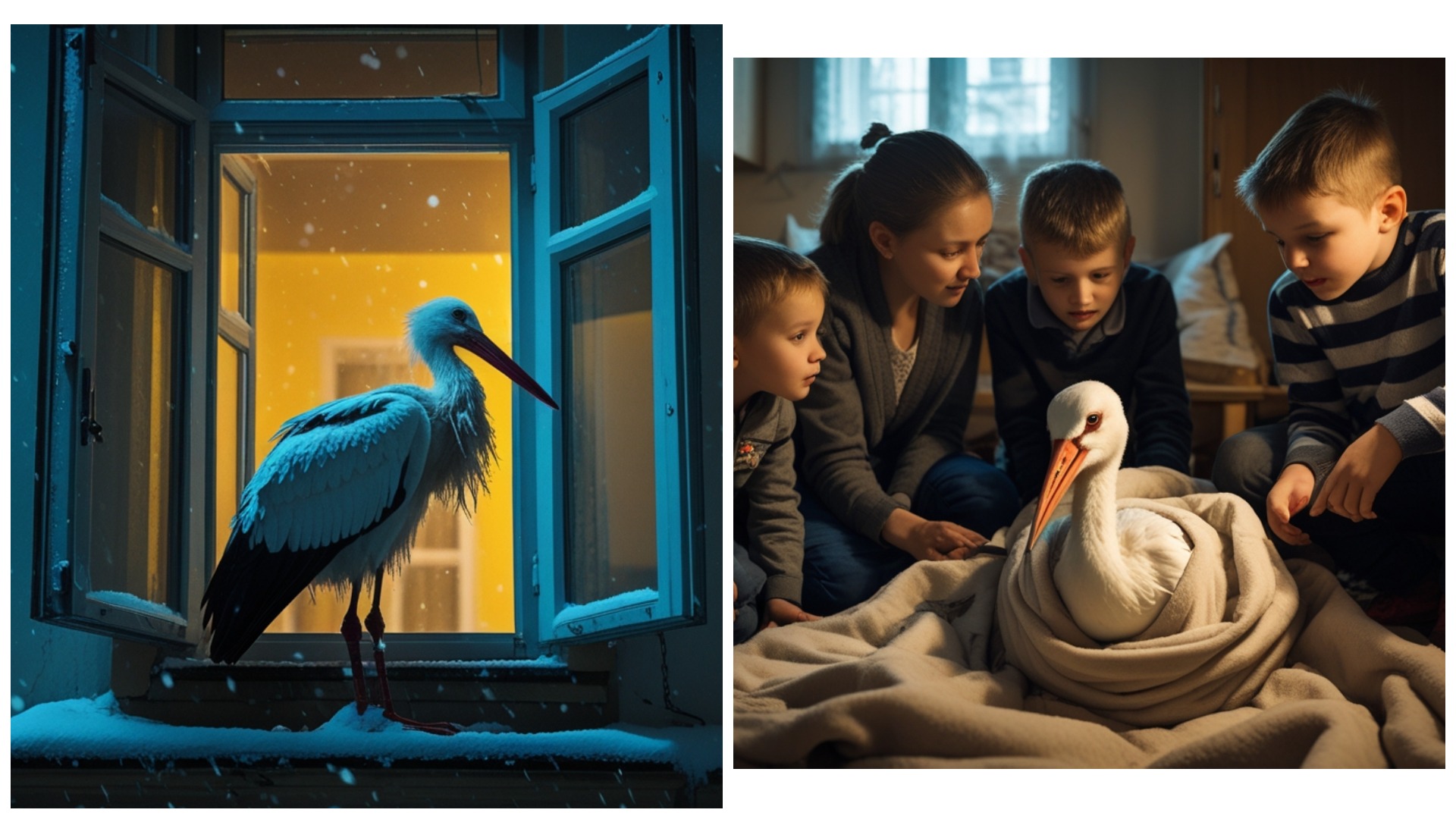It began quietly, on a frosty February night in Kraków, a city known for its cobblestone streets, medieval architecture, and bustling marketplaces. The Kowalski family lived in a modest flat not far from the Vistula River—ordinary people with ordinary struggles. Marek worked double shifts at a warehouse, while his wife Ania cared for their two young children.
That night, Ania had been awakened by strange scratching sounds near the kitchen window. At first, she thought it was a stray cat, common in their neighborhood. But when Marek switched on the light, both froze.

Perched on the narrow sill, wings trembling, was a white stork—Poland’s national bird, a symbol of family and renewal. But this stork was no graceful postcard figure. Its feathers were matted with ice, one wing hung awkwardly, and its eyes flickered with exhaustion.

The bird must have lost its way during migration. Storks usually travel from Europe to Africa for winter, but sudden weather shifts—linked to climate change, as biologists later confirmed—sometimes disoriented them. This one had clearly fought storms and cold, only to collapse in the wrong place.
Without hesitation, Ania whispered, “We can’t let it die.”
Marek hesitated. They lived in a small apartment, barely enough room for themselves. But when their daughter Zosia crept out, wide-eyed, and softly said, “Please, Papa,” his resistance melted.
They opened the window. The bird fell inside like a sack of feathers.

The hours that followed felt surreal. Wrapped in a blanket, the stork lay on the floor, its chest heaving. The children stroked its neck gently. Marek searched the internet: “injured stork what to do Poland.” Advice was scarce. Wildlife centers were closed for the night.
That’s when the commotion began.
Neighbors, hearing unusual noises, knocked on the door. Soon, half the building crowded the stairwell. Some accused them of being reckless: “It’s wild! It carries disease!” Others were touched: “They saved a national treasure!”
By dawn, police arrived after a worried tenant called emergency services. Officers entered, expecting perhaps a domestic quarrel, and instead found a nearly unconscious bird on the floor, surrounded by children feeding it bits of soaked bread.
The firefighters who followed were equally stunned. They contacted local biologists from the Jagiellonian University, who rushed over in disbelief.
The scene went viral almost instantly. Videos posted by neighbors hit Facebook, TikTok, and Twitter within hours. Comments poured in:
-
“Only in Poland would someone save a stork in their flat!”
-
“This is climate change in real life.”
-
“Bless that family, they taught their kids compassion.”
By the time professionals carried the stork out in a special crate, the entire street applauded. Some filmed. Some cried. One elderly neighbor crossed herself and whispered, “It’s a sign.”
Scientists confirmed the stork had a broken wing but would recover with proper care. They praised the family’s courage, though they cautioned others not to attempt such rescues without expert guidance.

In the days that followed, reporters swarmed the building. The Kowalskis, overwhelmed, gave only one short statement: “We couldn’t just watch it die. Everyone deserves a chance to fly again.”
The children drew pictures of the stork, which they taped proudly to their window. Neighbors who had argued about safety later brought warm soup and blankets for the family, apologizing for their harsh words.
The stork, now nicknamed “Krakus” by social media, became a symbol of resilience. News outlets from Germany to the UK picked up the story, linking it to broader discussions about migration patterns, wildlife protection, and the unpredictable effects of global warming.
Weeks later, when Krakus spread its wings again in a rehabilitation center and managed to take short flights, the video reached millions. Children cheered, strangers shared the clip with captions like “Hope survives.”
The Kowalski family returned to their quiet life. But sometimes, when neighbors pass their door, they smile and whisper: “That’s where the stork slept.”
And for Ania and Marek, the memory remains—of one frozen night when their home became a sanctuary, and an ordinary family’s act of kindness gave a national bird a second chance.
✨ Conclusion:
The story of the Kowalskis and Krakus isn’t just about a bird. It’s about compassion in the face of hardship, about ordinary people who chose empathy over fear, and about the thin line between chaos and miracle.
And maybe—just maybe—it’s also about how even the smallest apartment can become the stage for something extraordinary.

